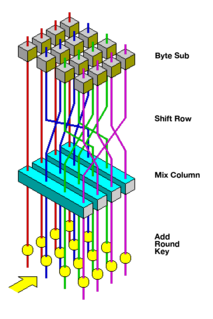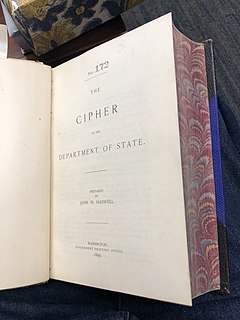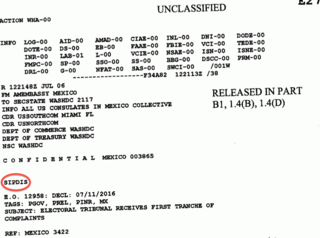 W
WCryptography, or cryptology, is the practice and study of techniques for secure communication in the presence of adversarial behavior. More generally, cryptography is about constructing and analyzing protocols that prevent third parties or the public from reading private messages; various aspects in information security such as data confidentiality, data integrity, authentication, and non-repudiation are central to modern cryptography. Modern cryptography exists at the intersection of the disciplines of mathematics, computer science, electrical engineering, communication science, and physics. Applications of cryptography include electronic commerce, chip-based payment cards, digital currencies, computer passwords, and military communications.
 W
WThe Advanced Encryption Standard (AES), also known by its original name Rijndael, is a specification for the encryption of electronic data established by the U.S. National Institute of Standards and Technology (NIST) in 2001.
 W
WA backdoor is a typically covert method of bypassing normal authentication or encryption in a computer, product, embedded device, or its embodiment. Backdoors are most often used for securing remote access to a computer, or obtaining access to plaintext in cryptographic systems. From there it may be used to gain access to privileged information like passwords, corrupt or delete data on hard drives, or transfer information within autoschediastic networks.
 W
WBitcoin Gold (BTG) is a cryptocurrency. It is a hard fork of Bitcoin, the open source cryptocurrency. It is an open source, decentralized digital currency without a central bank or intermediary that can be sent from user to user on the peer-to-peer Bitcoin Gold network.
 W
WIn cryptography, a cipher is an algorithm for performing encryption or decryption—a series of well-defined steps that can be followed as a procedure. An alternative, less common term is encipherment. To encipher or encode is to convert information into cipher or code. In common parlance, "cipher" is synonymous with "code", as they are both a set of steps that encrypt a message; however, the concepts are distinct in cryptography, especially classical cryptography.
 W
WIn cryptography, ciphertext or cyphertext is the result of encryption performed on plaintext using an algorithm, called a cipher. Ciphertext is also known as encrypted or encoded information because it contains a form of the original plaintext that is unreadable by a human or computer without the proper cipher to decrypt it. Thus preventing loss of sensitive information via hacking. Decryption, the inverse of encryption, is the process of turning ciphertext into readable plaintext. Ciphertext is not to be confused with codetext because the latter is a result of a code, not a cipher.
 W
WIn cryptology, a code is a method used to encrypt a message that operates at the level of meaning; that is, words or phrases are converted into something else. A code might transform "change" into "CVGDK" or "cocktail lounge". The U.S. National Security Agency defined a code as "A substitution cryptosystem in which the plaintext elements are primarily words, phrases, or sentences, and the code equivalents typically consist of letters or digits in otherwise meaningless combinations of identical length." A codebook is needed to encrypt, and decrypt the phrases or words.
 W
WA codebook is a type of document used for gathering and storing cryptography codes. Originally codebooks were often literally books, but today codebook is a byword for the complete record of a series of codes, regardless of physical format.
 W
WCommunications security is the discipline of preventing unauthorized interceptors from accessing telecommunications in an intelligible form, while still delivering content to the intended recipients.
 W
WComputer security, cybersecurity or information technology security is the protection of computer systems and networks from information disclosure, theft of or damage to their hardware, software, or electronic data, as well as from the disruption or misdirection of the services they provide.
 W
WCryptanalysis is the study of analyzing information systems in order to study the hidden aspects of the systems. Cryptanalysis is used to breach cryptographic security systems and gain access to the contents of encrypted messages, even if the cryptographic key is unknown.
 W
WThe Crypto Wars is an unofficial name for the U.S. and allied governments' attempts to limit the public's and foreign nations' access to cryptography strong enough to resist decryption by national intelligence agencies.
 W
WA cryptographic hash function (CHF) is a mathematical algorithm that maps data of arbitrary size to a bit array of a fixed size. It is a one-way function, that is, a function which is practically infeasible to invert or reverse the computation. Ideally, the only way to find a message that produces a given hash is to attempt a brute-force search of possible inputs to see if they produce a match, or use a rainbow table of matched hashes. Cryptographic hash functions are a basic tool of modern cryptography.
 W
WIn cryptography, a nonce is an arbitrary number that can be used just once in a cryptographic communication. It is similar in spirit to a nonce word, hence the name. It is often a random or pseudo-random number issued in an authentication protocol to ensure that old communications cannot be reused in replay attacks. They can also be useful as initialization vectors and in cryptographic hash functions.
 W
WCrypTool is an open-source project that focuses on the free e-learning software CrypTool illustrating cryptographic and cryptanalytic concepts. According to "Hakin9", CrypTool is worldwide the most widespread e-learning software in the field of cryptology.
 W
WCypherpunks: Freedom and the Future of the Internet is a 2012 book by Julian Assange, in discussion with Internet activists and cypherpunks Jacob Appelbaum, Andy Müller-Maguhn and Jérémie Zimmermann. Its primary topic is society's relationship with information security. In the book, the authors warn that the Internet has become a tool of the police state, and that the world is inadvertently heading toward a form of totalitarianism. They promote the use of cryptography to protect against state surveillance.
 W
WData at rest in information technology means data that is housed physically on computer data storage in any digital form. Data at rest includes both structured and unstructured data. This type of data is subject to threats from hackers and other malicious threats to gain access to the data digitally or physical theft of the data storage media. To prevent this data from being accessed, modified or stolen, organizations will often employ security protection measures such as password protection, data encryption, or a combination of both. The security options used for this type of data are broadly referred to as data at rest protection (DARP).
 W
WDigiDoc is a family of digital signature- and cryptographic computing file formats utilizing a public key infrastructure. It currently has three generations of sub formats, DDOC-, a later binary based BDOC and currently used ASiC-E format that is supposed to replace the previous generation formats. DigiDoc was created and is developed and maintained by RIA.
 W
WA diplomatic bag, also known as a diplomatic pouch, is a container with certain legal protections used for carrying official correspondence or other items between a diplomatic mission and its home government or other diplomatic, consular, or otherwise official entity. The physical concept of a "diplomatic bag" is flexible and therefore can take many forms.
 W
WThe Discriminant Book shortened to K-Book (K. Buch), and also known as the indicator group book or identification group book was a secret distribution list in booklet form, which listed trigraphs in random order. The Kenngruppenbuch was introduced in May 1937, and used by the Kriegsmarine during World War II as part of the Naval Enigma message encipherment procedure, to ensure secret and confidential communication between Karl Dönitz, Commander of Submarines (BdU) in the Atlantic and in the Mediterranean operating German submarines. The Kenngruppenbuch was used in the generation of the Enigma message Key that was transmitted within the message Indicator. The Kenngruppenbuch was used from 5 October 1941, for the Enigma Model M3, and from 1 February 1942 exclusively for the Enigma M4. It must not be confused with the Kenngruppenheft which was used with the Short Signal Book.
 W
WIn cryptography, the EFF DES cracker is a machine built by the Electronic Frontier Foundation (EFF) in 1998, to perform a brute force search of the Data Encryption Standard (DES) cipher's key space – that is, to decrypt an encrypted message by trying every possible key. The aim in doing this was to prove that the key size of DES was not sufficient to be secure.
 W
WIn cryptography, encryption is the process of encoding information. This process converts the original representation of the information, known as plaintext, into an alternative form known as ciphertext. Ideally, only authorized parties can decipher a ciphertext back to plaintext and access the original information. Encryption does not itself prevent interference but denies the intelligible content to a would-be interceptor.
 W
WThe Enigma machine is a cipher device developed and used in the early- to mid-20th century to protect commercial, diplomatic, and military communication. It was employed extensively by Nazi Germany during World War II, in all branches of the German military. The Germans believed, erroneously, that use of the Enigma machine enabled them to communicate securely and thus enjoy a huge advantage in World War II. The Enigma machine was considered to be so secure that even the most top-secret messages were enciphered on its electrical circuits.
 W
WIn computing, a hardware random number generator (HRNG) or true random number generator (TRNG) is a device that generates random numbers from a physical process, rather than by means of an algorithm. Such devices are often based on microscopic phenomena that generate low-level, statistically random "noise" signals, such as thermal noise, the photoelectric effect, involving a beam splitter, and other quantum phenomena. These stochastic processes are, in theory, completely unpredictable, and the theory's assertions of unpredictability are subject to experimental test. This is in contrast to the paradigm of pseudo-random number generation commonly implemented in computer programs.
 W
WHardware-based encryption is the use of computer hardware to assist software, or sometimes replace software, in the process of data encryption. Typically, this is implemented as part of the processor's instruction set. For example, the AES encryption algorithm can be implemented using the AES instruction set on the ubiquitous x86 architecture. Such instructions also exist on the ARM architecture. However, more unusual systems exist where the cryptography module is separate from the central processor, instead being implemented as a coprocessor, in particular a secure cryptoprocessor or cryptographic accelerator, of which an example is the IBM 4758, or its successor, the IBM 4764. Hardware implementations can be faster and less prone to exploitation than traditional software implementations, and furthermore can be protected against tampering.
 W
WHuman rights applied to encryption is an important concept for freedom of expression as encryption is a technical resource of implementation of basic human rights.
 W
WRussell Graham Impagliazzo is a professor of computer science at the University of California, San Diego specializing in computational complexity theory. He obtained a doctorate from the University of California, Berkeley. His advisor was Manuel Blum. He is a 2004 Guggenheim fellow.
 W
WInformation Security, sometimes shortened to InfoSec, is the practice of protecting information by mitigating information risks. It is part of information risk management. It typically involves preventing or reducing the probability of unauthorized/inappropriate access to data, or the unlawful use, disclosure, disruption, deletion, corruption, modification, inspection, recording, or devaluation of information. It also involves actions intended to reduce the adverse impacts of such incidents. Protected information may take any form, e.g. electronic or physical, tangible or intangible. Information security's primary focus is the balanced protection of the confidentiality, integrity, and availability of data while maintaining a focus on efficient policy implementation, all without hampering organization productivity. This is largely achieved through a structured risk management process that involves:identifying information and related assets, plus potential threats, vulnerabilities, and impacts; evaluating the risks; deciding how to address or treat the risks i.e. to avoid, mitigate, share or accept them; where risk mitigation is required, selecting or designing appropriate security controls and implementing them; monitoring the activities, making adjustments as necessary to address any issues, changes and improvement opportunities.
 W
WThe Key Management Interoperability Protocol (KMIP) is an extensible communication protocol that defines message formats for the manipulation of cryptographic keys on a key management server. This facilitates data encryption by simplifying encryption key management. Keys may be created on a server and then retrieved, possibly wrapped by other keys. Both symmetric and asymmetric keys are supported, including the ability to sign certificates. KMIP also allows for clients to ask a server to encrypt or decrypt data, without needing direct access to the key.
 W
WThe knapsack problem is a problem in combinatorial optimization: Given a set of items, each with a weight and a value, determine the number of each item to include in a collection so that the total weight is less than or equal to a given limit and the total value is as large as possible. It derives its name from the problem faced by someone who is constrained by a fixed-size knapsack and must fill it with the most valuable items. The problem often arises in resource allocation where the decision makers have to choose from a set of non-divisible projects or tasks under a fixed budget or time constraint, respectively.
 W
WIn mathematics, the goal of lattice basis reduction is given an integer lattice basis as input, to find a basis with short, nearly orthogonal vectors. This is realized using different algorithms, whose running time is usually at least exponential in the dimension of the lattice.
 W
WThe Microsoft Security Development Lifecycle is a software development process used and proposed by Microsoft to reduce software maintenance costs and increase reliability of software concerning software security related bugs. It is based on the classical spiral model.
 W
WMix networks are routing protocols that create hard-to-trace communications by using a chain of proxy servers known as mixes which take in messages from multiple senders, shuffle them, and send them back out in random order to the next destination. This breaks the link between the source of the request and the destination, making it harder for eavesdroppers to trace end-to-end communications. Furthermore, mixes only know the node that it immediately received the message from, and the immediate destination to send the shuffled messages to, making the network resistant to malicious mix nodes.
 W
WLambert Sonna Momo is a Swiss computer scientist of Cameroonian origin. He is known for his work in electronic identification through biometrics.
 W
WIn cryptography, the one-time pad (OTP) is an encryption technique that cannot be cracked, but requires the use of a single-use pre-shared key that is no smaller than the message being sent. In this technique, a plaintext is paired with a random secret key. Then, each bit or character of the plaintext is encrypted by combining it with the corresponding bit or character from the pad using modular addition.
 W
WPassword strength is a measure of the effectiveness of a password against guessing or brute-force attacks. In its usual form, it estimates how many trials an attacker who does not have direct access to the password would need, on average, to guess it correctly. The strength of a password is a function of length, complexity, and unpredictability.
 W
WPKIoverheid is the public key infrastructure (PKI) from the Dutch government. Like any other PKI, the system issues and manages digital certificates such that they can be realized. PKIoverheid is run by Logius.
 W
WPublic-key cryptography, or asymmetric cryptography, is a cryptographic system that uses pairs of keys: public keys, and private keys. The generation of such key pairs depends on cryptographic algorithms which are based on mathematical problems termed one-way functions. Effective security requires keeping the private key private; the public key can be openly distributed without compromising security.
 W
WIn common parlance, randomness is the apparent or actual lack of pattern or predictability in events. A random sequence of events, symbols or steps often has no order and does not follow an intelligible pattern or combination. Individual random events are, by definition, unpredictable, but if the probability distribution is known, the frequency of different outcomes over repeated events is predictable. For example, when throwing two dice, the outcome of any particular roll is unpredictable, but a sum of 7 will tend to occur twice as often as 4. In this view, randomness is not haphazardness; it is a measure of uncertainty of an outcome. Randomness applies to concepts of chance, probability, and information entropy.
 W
WThe Sacher hexachord is a hexachord notable for its use in a set of twelve compositions created at the invitation of Mstislav Rostropovich for Sacher's seventieth birthday in 1976.
 W
WThe Schlüsselgerät 41, also known as the SG-41 or Hitler mill, was a rotor cipher machine, first produced in 1941 in Nazi Germany, that was designed as a potential successor for the Enigma machine. It saw limited use by the Abwehr towards the end of World War II.
 W
WSecure voice is a term in cryptography for the encryption of voice communication over a range of communication types such as radio, telephone or IP.
 W
WSignals intelligence (SIGINT) is intelligence-gathering by interception of signals, whether communications between people or from electronic signals not directly used in communication. Signals intelligence is a subset of intelligence collection management. As sensitive information is often encrypted, signals intelligence in turn involves the use of cryptanalysis to decipher the messages. Traffic analysis—the study of who is signaling whom and in what quantity—is also used to integrate information again.
 W
WA SIGINT Activity Designator identifies a signals intelligence (SIGINT) line of collection activity associated with a signals collection station, such as a base or a ship. For example, the SIGAD for Menwith Hill in the UK is USD1000. SIGADs are used by the signals intelligence agencies of the United States, the United Kingdom, Canada, Australia and New Zealand.
 W
WThe Secret Internet Protocol Router Network (SIPRNet) is "a system of interconnected computer networks used by the U.S. Department of Defense and the U.S. Department of State to transmit classified information by packet switching over the 'completely secure' environment". It also provides services such as hypertext document access and electronic mail. As such, SIPRNet is the DoD's classified version of the civilian Internet.
 W
WTamperproofing, conceptually, is a methodology used to hinder, deter or detect unauthorised access to a device or circumvention of a security system. Since any device or system can be foiled by a person with sufficient knowledge, equipment, and time, the term "tamperproof" is a misnomer unless some limitations on the tampering party's resources is explicit or assumed.
 W
WThe Texas Instruments signing key controversy resulted from Texas Instruments' (TI) response to a project to factorize the 512-bit RSA cryptographic keys needed to write custom firmware to TI devices.
 W
WThe Three-stage quantum cryptography protocol, also known as Kak's three-stage protocol is a method of data encryption that uses random polarization rotations by both Alice and Bob, the two authenticated parties, that was proposed by Subhash Kak. In principle, this method can be used for continuous, unbreakable encryption of data if single photons are used. It is different from methods of QKD for it can be used for direct encryption of data, although it could also be used for exchanging keys.
 W
WTokenization, when applied to data security, is the process of substituting a sensitive data element with a non-sensitive equivalent, referred to as a token, that has no extrinsic or exploitable meaning or value. The token is a reference that maps back to the sensitive data through a tokenization system. The mapping from original data to a token uses methods that render tokens infeasible to reverse in the absence of the tokenization system, for example using tokens created from random numbers. The tokenization system must be secured and validated using security best practices applicable to sensitive data protection, secure storage, audit, authentication and authorization. The tokenization system provides data processing applications with the authority and interfaces to request tokens, or detokenize back to sensitive data.
 W
WTor, short for The Onion Router, is free and open-source software for enabling anonymous communication. It directs Internet traffic through a free, worldwide, volunteer overlay network, consisting of more than six thousand relays, for concealing a user's location and usage from anyone conducting network surveillance or traffic analysis. Using Tor makes it more difficult to trace the Internet activity to the user. Tor's intended use is to protect the personal privacy of its users, as well as their freedom and ability to conduct confidential communication by keeping their Internet activities unmonitored.
 W
WA trapdoor function is a function that is easy to compute in one direction, yet difficult to compute in the opposite direction without special information, called the "trapdoor". Trapdoor functions are widely used in cryptography.
 W
WITU-T Recommendation X.1035 specifies a password-authenticated key agreement protocol that ensures mutual authentication of two parties by using a Diffie–Hellman key exchange to establish a symmetric cryptographic key. The use of Diffie-Hellman exchange ensures perfect forward secrecy—a property of a key establishment protocol that guarantees that compromise of a session key or long-term private key after a given session does not cause the compromise of any earlier session.
 W
WZcash is a cryptocurrency aimed at using cryptography to provide enhanced privacy for its users compared to other cryptocurrencies such as Bitcoin.